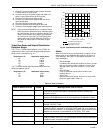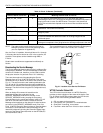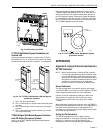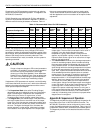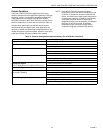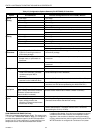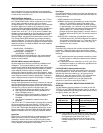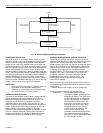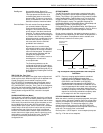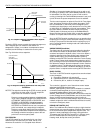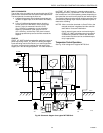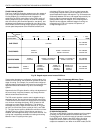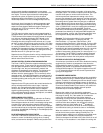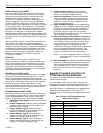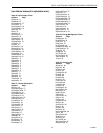
EXCEL 10 W7750A,B,C CONSTANT VOLUME AHU CONTROLLER
74-2958—156
Fig. 45. LED and Bypass pushbutton operation.
STANDBY MODE (StatusOcySen)
The di
g
ital input for an occupanc
y
sensor
(
usuall
y
a motion
detector or possibl
y
a time clock
)
provides the controller with a
means to enter an ener
gy
-savin
g
Standb
y
mode whenever
people are not in the room. Standb
y
mode occurs when the
scheduled occupanc
y
is Occupied, and the occupanc
y
sensor
detects no people currentl
y
in the room
(
di
g
ital input contacts
Closed means people are in the room, and contacts Open
means the room is Unoccupied
)
. When in Standb
y
mode, the
Excel 10 W7750 Controller uses the Standb
y
Coolin
g
Setpoint
for coolin
g
(
CoolStb
y
Spt
)
, or the Standb
y
Heatin
g
Setpoint for
Heatin
g
(
HeatStb
y
Spt
)
as the Actual Space Temperature
Setpoint. The occupanc
y
sensor si
g
nal can also be a network
input from another L
ON
W
ORKS
Bus device, so that no ph
y
sical
sensor is re
q
uired at the receivin
g
W7750 Controller.
IMPORTANT
When the W7750 Controller is in Standby mode, the
economizer minimum position setting is
not
observed. This means the fresh air dampers will go
fully closed if there is no call for cooling.
CONTINUOUS UNOCCUPIED MODE
This mode is entered when a wall module is confi
g
ured with a
B
y
pass pushbutton that was pressed for four to seven
seconds causin
g
the wall module LED/LCD to blink. This
mode can also be entered via a network command
(
ManualOcc set to Unoccupied
)
. If the controller is in this
mode, it reverts to the Unoccupied setpoints for temperature
control, and the economizer does not observe its minimum
position settin
g
. The controller remains in this mode
indefinitel
y
until the B
y
pass pushbutton is pressed to exit the
mode or a network command is sent to clear the mode. A
confi
g
uration parameter is available to disable wall-module
initiation of Continuous Unoccupied mode
(
OvrdT
y
pe
)
.
OCCUPANCY MODE AND MANUAL OVERRIDE ARBITRATION
The W7750 has multiple sources for occupanc
y
schedule
information and, therefore, it emplo
y
s an arbitration scheme to
determine the current actual mode. Time-of-da
y
(
TOD
)
schedule status comes from two sources, a confi
g
ured di
g
ital
input for OccTimeClock or the DestSchedOcc network input
received from a central control. If the di
g
ital input source is
confi
g
ured, it has hi
g
hest priorit
y
and determines the
Occupanc
y
mode. This di
g
ital input is either ON
(
shorted =
occupied
)
, OFF
(
open = unoccupied
)
, or not active
(
not
confi
g
ured
)
; otherwise, the status is determined b
y
the
DestSchedOcc input from the network source. The
DestSchedOcc has three possible states, occupied,
unoccupied or standb
y
.
Manual Override Status can be derived from three sources
and
g
overned b
y
two selectable arbitration schemes. The two
schemes are:
• Network Wins or Last-in Wins, as set in OvrdPriorit
y
.
The three sources of manual override status are:
DestManOcc - Has possible states: Occupied,
Unoccupied, B
y
pass, Standb
y
and Not
Assi
g
ned
(
not active
)
. This input source
has the hi
g
hest priorit
y
in determinin
g
manual override status for a Network
Wins arbitration scheme, and in the
event there is more than one source
chan
g
e at a time in the Last-in Wins
arbitration scheme. Here, b
y
pass
initiates a self-timed b
y
pass of the
control unit and expires upon
completion of the defined timed period.
The controller then treats the b
y
pass
status of this input as Not Assi
g
ned until
the next chan
g
e in status.
M8483A
RESET
NOT ASSIGNED
(LED OFF)
PRESS FOR ONE
TO FOUR SECONDS
BYPASS OCCUPIED
(LED ON)
BYPASS
TIMEOUT
PRESS FOR FOUR
TO SEVEN SECONDS
PRESS FOR LESS
THAN ONE SECOND
UNOCCUPIED
(LED BLINK)
PRESS FOR LESS THAN ONE SECOND
PRESS FOR MORE THAN SEVEN SECONDS




